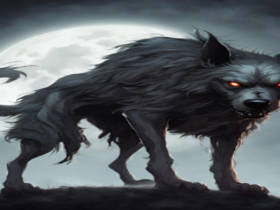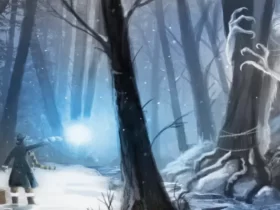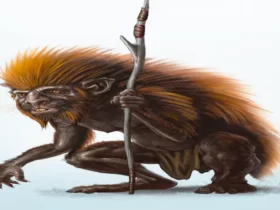There are several cryptids in cryptozoology that are often described as apes or ape-like creatures. According to reports, Urayuli are creatures resembling apes, residing in the southwest region of Alaska. These creatures are believed to be around 10 feet tall, covered in lengthy shaggy hair and have glowing eyes. They are also believed to emit a high-pitched wail, similar to a loon’s. Additionally, their thin, lengthy arms are said to extend down to their ankles.
Children Lost Into The Woods Turned Mysteriously Into A Urayuli

The Urayuli are believed to inhabit the woods close to Lake Iliamna and are reputed to be gentle creatures, which is unlike the Kushtaka that are found in the southeastern part of Alaska.
According to the story, the Urayuli are actually children who wander off and get lost in the forest at night, but later transform into these creatures. It is likely that this legend was created to discourage children from venturing out at night.
Similar Version Of Urayuli
It is referred to by various other names, including Hairy men, Arulataq, Bushman, Big Man, Tent Monster, Nant’ina, and Woodsman.
Physical Description

The Urayuli is believed to measure between 6 to 10 feet in height and has rough, shaggy fur ranging from 2 to 4 inches long. It has luminescent eyes and is purported to resemble primates that no longer exist. The creature’s arms are lengthy enough to allow it to touch its ankles.
Similar Read: Yowie Monster: Facts, Sightings & Folklore (Real Or Hoax?)
Anecdote Sightings/Encounters With Urayuli

The Urayuli are known to inhabit the bigger area of tundra surrounding Lake Iliamna in Alaska. This swift and nimble cryptid is frequently spotted moving about during the night and is also an adept swimmer. It is often held responsible for pilfering fish and canines, as well as damaging the tents of nearby campers. Many individuals from this area have shared their personal encounters with this creature.
During the year 1956, a fisherman observed the Urayuli while he was securing his fishing vessel on the shoreline at night. Subsequently, a biologist from Ketchikan discovered and captured a photograph of substantial footprints that resembled those of a human on the same beach.
During July of 1999, a group of individuals spotted a pair of massive, wedge-shaped footprints in the mud along the Kiseralik River in Alaska, and they were able to capture a photograph of them. The footprints were believed to measure around 12 to 14 inches in length and 3 inches in depth, and were estimated to be separated by at least 6 feet.
In 1982, a hunting guide from the city of Dillingham presented a photograph that he had captured of the Urayuli standing on a mountain ridge. The creature was roughly 10 feet tall, weighed approximately 750 pounds, and had lengthy reddish-brown fur.
During 1999, an enormous black-haired creature was observed standing upright on two legs in Cold Bay near Belkofski. It had an estimated height of 14 feet and resembled an ape, possessing very elongated arms and legs.
Urayuli Are One Of The Safest Cryptid To Encounter With
Interactions with the Urayuli are generally peaceful and uneventful. However, like any other living creature, it is likely to protect itself if it senses that its survival is at risk.
Urayuli Live In The Similar Place Where Iliamna Lake Monster Was Known To Exist
The Iliamna Lake Monster, also known as Illie to locals and Gonakadet in Tlingit or Jig-ik-nak in Aleutian, is a cryptid that supposedly lives in the waters of the small Alaskan fishing village of Iliamna. According to native legends, the creature is a large beast that inhabits the lake and has been spotted numerous times. Some accounts even claim that the creature has caused deaths. The monster has garnered enough attention over the years to attract the Animal Planet show “River Monsters,” which attempted to uncover the secrets of the lake’s depths. Reports describe the monster as measuring 10-30 feet in length and having a square-shaped head that can deliver powerful blows to small boats. Despite the lack of concrete evidence, many sightings have convinced people of the monster’s existence.
Also Read: Werehyena: 14 Intriguing Facts (With Myths, Folklore & Cryptozoology)
Some Other Cryptids That May Resemble With Urayuli In Many Aspects
The Hairy Man, another mysterious creature with comparable traits, has been seen in the southern region of Valdez, Alaska. This Bigfoot-like creature is similar to the Urayuli, with one significant difference being that the Hairy Man appears to be more hostile. Another variation is that there seem to be multiple Hairy Men, whereas the Urayuli are often spoken of in the singular form. It is possible that these two cryptids are the same, but the difference in their temperament remains unclear.
The Skunk Ape

The Skunk Ape is a cryptid that can be found in the Florida Everglades. It has typical characteristics of a mysterious creature and is said to have the ability to cause cameras to malfunction. Dave Shealy, who claims to be an expert on the Skunk Ape, had his first encounter with the creature in 1974 at the age of ten. According to him, he saw the creature but it quickly disappeared.
Chuchuna

Chuchuna is a large creature, about the size of a basketball player, that reportedly lives in Siberia. It is known for its alleged habit of feeding on human flesh, like many other cryptids. According to cryptozoologists, Professor Peter Dravet from Omsk University became angry in 1933 when he heard reports of people in Siberia hunting Chuchuna, and he called on the Soviet Union to stop the killing. However, the government in Moscow was preoccupied with other matters, such as the Ukrainian famine, which resulted in millions of deaths. In the 1970s, a geologist named Vladimir Pushkarev searched for Chuchuna and concluded that the species was extinct.
Barmanou

Barmanou is a cryptid that fits the typical description – it is large, covered in hair, walks on two legs, and is said to kidnap young women for mating. Shepherds in the north-western region of Pakistan claimed to have spotted the creature, prompting Spanish zoologist Jordi Magraner to embark on a search for it. However, he was found murdered in August 2002. Despite being a possible suspect, Barmanou has remained elusive and has not surrendered to the authorities.
References:
Sherwonit, Bill (2008). Living with Wildness: An Alaskan Odyssey. University of Alaska Press. p. 195Mary J. Barry, Alaska’s Ghosts, Enigmas, Outlaws and Things That Go Bump! p.73-5.





